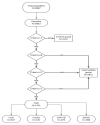Female Sexual Dysfunction in Association with Sexual History, Sexual Abuse and Satisfaction: A Cross-Sectional Study in Hungary
- PMID: 36769759
- PMCID: PMC9918233
- DOI: 10.3390/jcm12031112
Female Sexual Dysfunction in Association with Sexual History, Sexual Abuse and Satisfaction: A Cross-Sectional Study in Hungary
Abstract
Female sexual dysfunction (FSD) has a negative impact on women's quality of life, self-esteem, and physical health. The aim of the present study was to explore the prevalence and the factors associated with FSD using an online questionnaire. A cross-sectional survey was conducted among young adults (18-35 years old) in Hungary using the DSM-5 criteria. The participants (n = 5942) were divided into three major groups: FSD (20.3%), an intermediate group (43.9%), and a control group (35.6%). Most of the women showing FSD were affected with female orgasmic disorder (9.2%) and genito-pelvic pain/penetration disorder (4.6%), while female sexual interest/arousal disorder was found in altogether 100 women (1.7%); 4.8% of women were affected by more than one definite disorder. The occurrence of female sexual dysfunction was related to the women's previous sexual history (first sexual experience, sexual education, early encounter with pornographic content, and sexual abuse), their self-satisfaction (with their own body, genitalia, and sexual attraction), and their sexual orientation. Sexual dysfunction showed a strong association with abuse, sexually transmitted diseases, and self-esteem. The present study identified the relationship between sexual dysfunctions and other health conditions, which can be the basis for some form of screening and early assistance programs for FSD.
Keywords: DSM-5; female sexual dysfunction; satisfaction; sexual abuse; sexual disorder; sexual history.
Conflict of interest statement
The authors declare no conflict of interest.
Figures

Similar articles
-
Sexual Dysfunctions in Women with Posttraumatic Stress Disorder Following Childhood Sexual Abuse: Prevalence Rates According to DSM-5 and Clinical Correlates.Arch Sex Behav. 2023 Nov;52(8):3365-3378. doi: 10.1007/s10508-023-02652-0. Epub 2023 Jul 19. Arch Sex Behav. 2023. PMID: 37468726 Free PMC article.
-
Evaluation of sexual dysfunction in gynecologic cancer survivors using DSM-5 diagnostic criteria.BMC Womens Health. 2022 Jan 5;22(1):1. doi: 10.1186/s12905-021-01559-z. BMC Womens Health. 2022. PMID: 34986812 Free PMC article.
-
Sexual dysfunction among reproductive-aged Chinese married women in Hong Kong: prevalence, risk factors, and associated consequences.J Sex Med. 2015 Mar;12(3):738-45. doi: 10.1111/jsm.12791. Epub 2014 Dec 3. J Sex Med. 2015. PMID: 25470214
-
Female Sexual Dysfunction After Pelvic Fracture: A Comprehensive Review of the Literature.J Sex Med. 2021 Mar;18(3):467-473. doi: 10.1016/j.jsxm.2020.12.014. Epub 2021 Feb 13. J Sex Med. 2021. PMID: 33593705
-
Toward a More Evidence-Based Nosology and Nomenclature for Female Sexual Dysfunctions-Part I.J Sex Med. 2016 Dec;13(12):1881-1887. doi: 10.1016/j.jsxm.2016.09.014. Epub 2016 Oct 12. J Sex Med. 2016. PMID: 27743749 Review.
Cited by
-
Comparing Relationship Satisfaction and Body-Image-Related Quality of Life in Pregnant Women with Planned and Unplanned Pregnancies.Diseases. 2024 May 22;12(6):109. doi: 10.3390/diseases12060109. Diseases. 2024. PMID: 38920541 Free PMC article.
-
Pornography-Watching Disorder and Its Risk Factors Among Young Adults: Cross-Sectional Survey.J Med Internet Res. 2025 Jan 8;27:e49860. doi: 10.2196/49860. J Med Internet Res. 2025. PMID: 39778200 Free PMC article.
-
Psychometric evaluation of the abbreviated Hungarian Faking Orgasm Scale for Women.Front Psychol. 2024 Dec 12;15:1513959. doi: 10.3389/fpsyg.2024.1513959. eCollection 2024. Front Psychol. 2024. PMID: 39726612 Free PMC article.
-
Sexual dysfunction in women with breast cancer of Northeast Brazil: a retrospective longitudinal study.Sci Rep. 2023 Nov 22;13(1):20441. doi: 10.1038/s41598-023-47684-7. Sci Rep. 2023. PMID: 37993511 Free PMC article.
-
Sexual dysfunction in migraine-affected women: A prospective cross-sectional controlled study.Eur J Obstet Gynecol Reprod Biol X. 2024 Jun 22;23:100319. doi: 10.1016/j.eurox.2024.100319. eCollection 2024 Sep. Eur J Obstet Gynecol Reprod Biol X. 2024. PMID: 39035702 Free PMC article.
References
-
- Rosen R., Brown C., Heiman J., Leiblum S., Meston C., Shabsigh R., Ferguson D., D’Agostino R., Jr. The Female Sexual Function Index (FSFI): A multidimensional self-report instrument for the assessment of female sexual function. J. Sex Marital Ther. 2000;26:191–208. doi: 10.1080/009262300278597. - DOI - PubMed
-
- Goldstein I., Kim N.N., Clayton A.H., DeRogatis L.R., Giraldi AParish S.J., Pfaus J., Simon J.A., Kingsberg S.A., Meston C., Stahl S.M., et al. Hypoactive Sexual Desire Disorder: International Society for the Study of Women’s Sexual Health (ISSWSH) Expert Consensus Panel Review. Mayo Clin. Proc. 2017;92:114–128. doi: 10.1016/j.mayocp.2016.09.018. - DOI - PubMed
LinkOut - more resources
Full Text Sources

